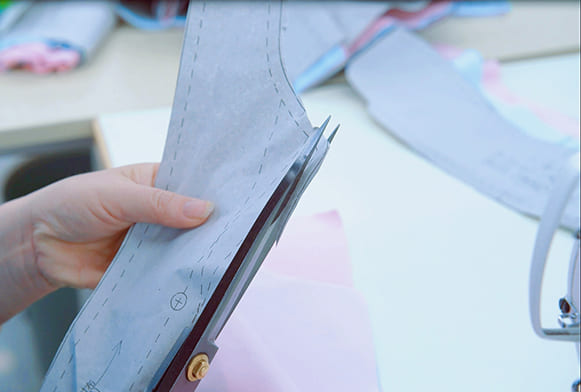Antibacterial And Odor-Removing Fabrics-Copper Fabrics

The epidemic in 2020 has made people re-examine the meaning of our healthy life and pay more and more attention to health. Life is the only thing, health is the only thing, and without health, everything becomes empty talk. Therefore, human life and health have received unprecedented attention, and as a business, changes in customer needs will give rise to new technologies and material changes. As the first priority for people's food, home clothing, housing and transportation, the innovation of textile fabrics has become a trend. Antibacterial technology is increasingly used in the sleepwear textile industry. According to relevant experts, in the next few years, the annual growth rate of the global antibacterial fabric market can reach 10%, and health, naturalness and environmental protection will become the development trend of textiles.
The emergence of fabrics is a truly disruptive change in antibacterial fabrics. It is safe and efficient. It is different from the infiltration of various preparation extracts into fabrics yarns (the sterilization effect is general and weakens with the increase in the number of washings) and is also different from the metal chemical ion inhibition window (very active and easy to enter the skin pores and not easy to metabolize). It is a truly safe and healthy material. Copper fabrics uses high-tech technology to grind copper particles to less than 0.5um, and then adds it to the spinning after anti-oxidation modification of the surface. When made into polyester fabrics, it becomes the so-called copper-modified polyester fabrics and copper fabrics.
Copper - the guardian of life and health
Copper is one of the earliest metals used by humans. In the Yao, Shun and Yu era four or five thousand years ago, people were able to smelt bronze ware. In the Bronze Age of Xia, Shang and Zhou, complex and exquisite bronze sacrifices appeared. Today, the application of copper has penetrated into every field of our lives... Copper is one of the essential elements of the human body and an essential nutrient for the human body. An adult's body contains 50-120 mg of copper. Copper plays an important role in the metabolism of connective tissues such as human skin and cartilage. It can catalyze the synthesis of hemoglobin and participate in the hematopoietic process. Copper is also a component of some metal enzymes in the human body. Physiological processes such as bone marrow tissue collagen synthesis and skin and hair pigment metabolism cannot do without copper. Copper and zinc are both related to the metabolism of proteins and nucleic acids, which can make the skin delicate, the hair black and shiny, and make people rejuvenated and keep fit. Copper in serum has an integrating effect on toxins, can detoxify and improve the ability of white blood cells to kill bacteria, and has the effect of treating and preventing tumors or cancer. Scientific experiments have shown that copper can keep the contact surface clean, kill all bacteria within nine minutes, and prevent cross-infection of bacteria and viruses.
Copper fabrics
Copper modified polyfabrics, also known as copper fabrics, is a natural antibacterial care textile product that uses copper nano-materials and then implants it into polyester fabricss. Copper fabrics can effectively sterilize, deodorize and clean itself. It was awarded the National Invention Patent Certificate in 2014. After testing by national authoritative agencies, it has reached the highest AA-level standard in the national pajamas textile industry, with long-lasting antibacterial and antibacterial effects and is safe and harmless to the human body.
Copper fabrics is a functional fabrics made by high-tech nanotechnology, processing copper into micron-level particles, adding slices after surface antioxidant modification, melting into the textile melt, and spinning. It has long-lasting antibacterial and antibacterial effects and is safe and harmless to the human body. Nano copper is embedded in polymer fabricss through a melt extrusion process, and it is found that its antibacterial effect lasts longer than other similar antibacterial fabrics on the market, which are often surface coated, so each washing will weaken the antibacterial performance. Therefore, this is different from other post-finished antibacterial fabricss. The antibacterial property of copper fabrics does not decrease after washing, and it is safe and harmless to the human body (national Class B can directly contact the skin). It is a permanent antibacterial property existing in the fabrics.
In general, the resident bacteria on people's skin protect the skin from the harm of germs, but the sweat and sebum when wearing sleepwear provide a place for the reproduction and transmission of germs. Copper fabrics has an antibacterial rate of more than 99.9% against germs, and it is deodorizing and anti-mite, and it builds a safety barrier when worn close to the body. The detectable far-infrared emissivity value of copper fabrics is 0.98. When the temperature rises by 1.5 degrees under radiation, it can form the so-called function of promoting the blood flow rate on the body surface and improving microcirculation. The properties of the fabrics make the home clothes have obvious warmth retention, anti-odor and anti-mite, and self-cleaning ability, preventing bacteria and fungi from invading the skin.
Compared to other fabricss, copper fabrics has its own unique side. It uses highly decomposable molecules and nanotechnology to blend copper elements with fabricss and integrate them into one. It feels silky, has very good breathability, absorbs moisture and perspiration, and is dry and comfortable. It has become the first choice for close-fitting pajamas and pajamas. It has beautiful color, does not fade after washing, does not pill, and is washable. It has now become one of the most popular materials in the manufacture of home clothes. Close-fitting clothing is healthier.
Copper fabrics not only has the strength, elasticity, and wear resistance of polyester fabrics, but also has and surpasses the characteristics of pure cotton, such as softness, breathability, moisture absorption and quick drying, making it more comfortable to wear. The improved copper fabrics first essentially changes many limitations of polyester fabrics, such as poor moisture absorption and poor breathability, and has the comfort of pure cotton. It also uses the characteristics of copper to make the cortex produce collagen by itself, improve skin quality and appearance, and make the skin soft and smooth. The reason why fabrics become moldy, smelly, and rotten is that fabrics are prone to breeding bacteria and microorganisms in a long-term environment without direct sunlight or in a humid environment. Copper fabrics can not only inhibit bacteria and mold, kill or inhibit the growth of microorganisms, but also prevent odors produced by bacterial decomposition. Therefore, copper fabrics is a broad-spectrum, high-efficiency, safe and long-lasting antibacterial and odor-removing fabrics.
The emergence of fabrics is a truly disruptive change in antibacterial fabrics. It is safe and efficient. It is different from the infiltration of various preparation extracts into fabrics yarns (the sterilization effect is general and weakens with the increase in the number of washings) and is also different from the metal chemical ion inhibition window (very active and easy to enter the skin pores and not easy to metabolize). It is a truly safe and healthy material. Copper fabrics uses high-tech technology to grind copper particles to less than 0.5um, and then adds it to the spinning after anti-oxidation modification of the surface. When made into polyester fabrics, it becomes the so-called copper-modified polyester fabrics and copper fabrics.
Copper - the guardian of life and health
Copper is one of the earliest metals used by humans. In the Yao, Shun and Yu era four or five thousand years ago, people were able to smelt bronze ware. In the Bronze Age of Xia, Shang and Zhou, complex and exquisite bronze sacrifices appeared. Today, the application of copper has penetrated into every field of our lives... Copper is one of the essential elements of the human body and an essential nutrient for the human body. An adult's body contains 50-120 mg of copper. Copper plays an important role in the metabolism of connective tissues such as human skin and cartilage. It can catalyze the synthesis of hemoglobin and participate in the hematopoietic process. Copper is also a component of some metal enzymes in the human body. Physiological processes such as bone marrow tissue collagen synthesis and skin and hair pigment metabolism cannot do without copper. Copper and zinc are both related to the metabolism of proteins and nucleic acids, which can make the skin delicate, the hair black and shiny, and make people rejuvenated and keep fit. Copper in serum has an integrating effect on toxins, can detoxify and improve the ability of white blood cells to kill bacteria, and has the effect of treating and preventing tumors or cancer. Scientific experiments have shown that copper can keep the contact surface clean, kill all bacteria within nine minutes, and prevent cross-infection of bacteria and viruses.
Copper fabrics
Copper modified polyfabrics, also known as copper fabrics, is a natural antibacterial care textile product that uses copper nano-materials and then implants it into polyester fabricss. Copper fabrics can effectively sterilize, deodorize and clean itself. It was awarded the National Invention Patent Certificate in 2014. After testing by national authoritative agencies, it has reached the highest AA-level standard in the national pajamas textile industry, with long-lasting antibacterial and antibacterial effects and is safe and harmless to the human body.
Copper fabrics is a functional fabrics made by high-tech nanotechnology, processing copper into micron-level particles, adding slices after surface antioxidant modification, melting into the textile melt, and spinning. It has long-lasting antibacterial and antibacterial effects and is safe and harmless to the human body. Nano copper is embedded in polymer fabricss through a melt extrusion process, and it is found that its antibacterial effect lasts longer than other similar antibacterial fabrics on the market, which are often surface coated, so each washing will weaken the antibacterial performance. Therefore, this is different from other post-finished antibacterial fabricss. The antibacterial property of copper fabrics does not decrease after washing, and it is safe and harmless to the human body (national Class B can directly contact the skin). It is a permanent antibacterial property existing in the fabrics.
In general, the resident bacteria on people's skin protect the skin from the harm of germs, but the sweat and sebum when wearing sleepwear provide a place for the reproduction and transmission of germs. Copper fabrics has an antibacterial rate of more than 99.9% against germs, and it is deodorizing and anti-mite, and it builds a safety barrier when worn close to the body. The detectable far-infrared emissivity value of copper fabrics is 0.98. When the temperature rises by 1.5 degrees under radiation, it can form the so-called function of promoting the blood flow rate on the body surface and improving microcirculation. The properties of the fabrics make the home clothes have obvious warmth retention, anti-odor and anti-mite, and self-cleaning ability, preventing bacteria and fungi from invading the skin.
Compared to other fabricss, copper fabrics has its own unique side. It uses highly decomposable molecules and nanotechnology to blend copper elements with fabricss and integrate them into one. It feels silky, has very good breathability, absorbs moisture and perspiration, and is dry and comfortable. It has become the first choice for close-fitting pajamas and pajamas. It has beautiful color, does not fade after washing, does not pill, and is washable. It has now become one of the most popular materials in the manufacture of home clothes. Close-fitting clothing is healthier.
Copper fabrics not only has the strength, elasticity, and wear resistance of polyester fabrics, but also has and surpasses the characteristics of pure cotton, such as softness, breathability, moisture absorption and quick drying, making it more comfortable to wear. The improved copper fabrics first essentially changes many limitations of polyester fabrics, such as poor moisture absorption and poor breathability, and has the comfort of pure cotton. It also uses the characteristics of copper to make the cortex produce collagen by itself, improve skin quality and appearance, and make the skin soft and smooth. The reason why fabrics become moldy, smelly, and rotten is that fabrics are prone to breeding bacteria and microorganisms in a long-term environment without direct sunlight or in a humid environment. Copper fabrics can not only inhibit bacteria and mold, kill or inhibit the growth of microorganisms, but also prevent odors produced by bacterial decomposition. Therefore, copper fabrics is a broad-spectrum, high-efficiency, safe and long-lasting antibacterial and odor-removing fabrics.





Leave a comment